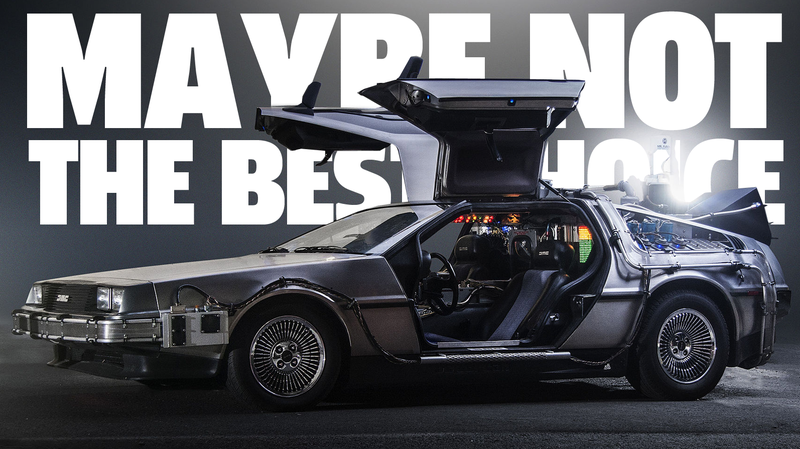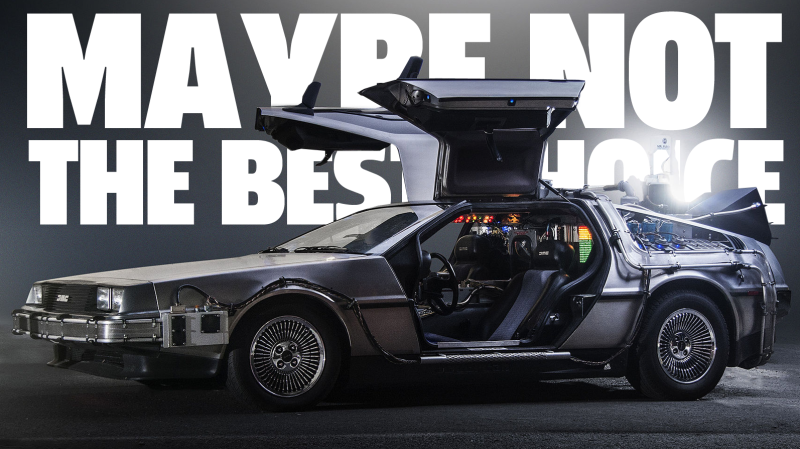
 CountersteerYour true stories of good and bad things that happen in cars.
CountersteerYour true stories of good and bad things that happen in cars.As we all know, the most famous example of a car turned into a machine to travel through time, not just space, is the DeLorean used in the Back to the Future movies. While dramatic and looking good for a movie, I’m not convinced this is actually a good choice at all for a time-travel vehicle. This question also came up on Reddit’s r/electricvehicles subbreddit, where a Redditor suggested that an EV is a better choice for a time machine. I’m not sure I buy that, either. Let’s think this through.
Okay, so, first, let’s look at the argument for an EV time machine-car as given on Reddit. Here was the argument:
“The major plot line of Back to the Future III revolves around needing to get the Delorean up to 88MPH when it is out of gasoline and gas won’t be refined for another half century or so.
Thinking big picture, gasoline will probably only be widely available for maybe a 200 year window of all human history.
While electrification wasn’t available for much time before the 20th century, it certainly isn’t going away. And even if Mr. Fusion never becomes reality, electricity is fairly easy to generate either with a stow-away solar panel (slow, but good enough in a pinch) or with materials available from any society that has refined metal.”
Advertisement
I think there’s a lot of problems here. In fact, much of the plot of Back to the Future dealt with the difficulties of acquiring the significant amount of power—1.21 gigawatts, if I recall—of electricity needed to get the flux capacitor to function.
Now, if we assume strict time-travel equipment power is a separate issue from how the time machine is propelled, even then, with the less demanding power requirements (but still non-trivial) of an EV drivetrain, it’s still a big deal to charge up an EV.
Even within the era of human history where electricity is being regularly generated, roughly from the 1890s until today, it’s only very, very recently—within the last decade or so—that any sort of high-speed charging would exist. For most of the past century, an EV-based time machine would have to recharge at slow 110V wall-outlet speeds, perhaps 220V if you’re outside the U.S. or Japan, but certainly no real high-speed charging.
The redditor’s suggestion that “electricity is fairly easy to generate either with a stow-away solar panel” is just not practical, at least not with currently available solar technology.
Advertisement
Also, I think the suggestion that electricity is easy to generate with “materials available from any society that has refined metal” is also a gross underestimation of the difficulties involved.
If you went to a pre-electrification era, you’d have to source magnets and metals to build a generator, including making copper wire for windings, and then figure out a way to spin it—waterwheel, wind, horse power, people held at knifepoint, steam engine, whatever—it’s not exactly a simple proposition.
Advertisement
And it’d have to be a pretty big generator, too—and you’d have to rectify the DC to AC, perhaps—it’s a huge pain in the ass. And you’d likely have to carry all that equipment with you, wherever you went, since there’s no network of electricity-generating.
An EV would make an awful time machine car, at least for travel to the past. For the future, sure, it may be ideal, but the problem with the future is that, well, we just don’t know, because it hasn’t happened yet.
Advertisement
So what would be better? To think about this, let’s consider a very simplified timeline of human history, based on available fuels and/or energy sources:

Advertisement
Okay, so, if we look at this, with its (very) rough listing of the sorts of fuels that would be relatively widely available to the intrepid automotive time-traveler, I think we can make some pretty clear guesses as to what sort of vehicle would be most able to keep going in any given era.
I think a properly-equipped diesel vehicle could be a good choice, since with proper filtration and fuel heaters, a diesel can burn most any kind of oil; it wouldn’t be much different than those diesel Mercedes wagons people were doing biodiesel conversions on to run on used french fry oil.
Advertisement
Such a diesel could likely run on whale oil or any number of natural oils, though some, like tallow, would take a bit of processing to be useful. Still, it’d be a hell of a lot easier to find in 1455 than electricity.

Advertisement
Another good option would be a woodgas-converted car. Woodgas has always been a sort of desperation fuel, and was perhaps most widely used in Europe during WWII when fuel rationing was at its strictest.
It’s not a particularily good-performing fuel, but you can pretty much find wood almost anywhere in the past. There are some notable exceptions, like ancient Egypt, and who knows about the future.
Advertisement
Even better would be something that could run on pretty much anything that burns. That’s why it may be that a steam-powered vehicle makes the most sense.
Anything you can use to get water boiling should work, even such wildly primitive fuels as dried animal (or, hell, even human) wastes. It’s not glamorous, but if you want to be absolutely certain you can be mobile, this may be the best bet. As technology improves, it’d be easy to adapt—a pocket atomic super-themo-heater could be used to boil water as well as bricks of cow dung, after all.
Advertisement
That’s just the fueling issue, though—if your goal is to blend in, then there’s a whole host of other factors. If you’re traveling in the era of automobiles, you’d want something that could fit in over as large an era as possible.
A DeLorean, by this metric, is a pretty crappy choice, as it always stands out, and before the 1980s would stand out as a huge gleaming stainless steel anachronism.
Advertisement
For much of the 20th century to now, a classic Volkswagen Beetle wouldn’t be a bad choice, since they remained (mostly) visually the same from the 1940s until the end of production in 2003. Sure, a later one would seem odd to people in the know, but most people would likely walk right by a 1970 Beetle sent to 1955.
The older and more common the car, generally, the better. In India, for example, a Hindustan Ambassador could be great, as it also kept its look for decades. In America, maybe any well-kept classic car could work, as it could pass as a normal car in, say, the 1930s, but be treated as just someone’s project car up until our era, and maybe beyond, though the further you go, the more attention it’ll draw.
Advertisement
In the pre-automotive era, though, you either have to really disguise the vehicle as a sort of carriage or some other animal-drawn conveyance, or perhaps, in the rail era, as a sort of road-locomotive. Or just accept that everyone’s going to assume you’re a witch or wizard if they catch you driving your dung-burning, steam-powered Ford Aerostar or whatever.
Also, you may be sleeping in this thing, or at least needing to use it for some private space away from the eyes and ears of the temporal locals? Maybe you’ll want a van, or something.
Advertisement
This isn’t an easy question; that’s why I want to hear from you! What sort of car makes the most sense as a time machine?













